Assignment about Indigenous Health 2022
VerifiedAdded on 2022/09/21
|9
|2230
|33
Assignment
AI Summary
Contribute Materials
Your contribution can guide someone’s learning journey. Share your
documents today.
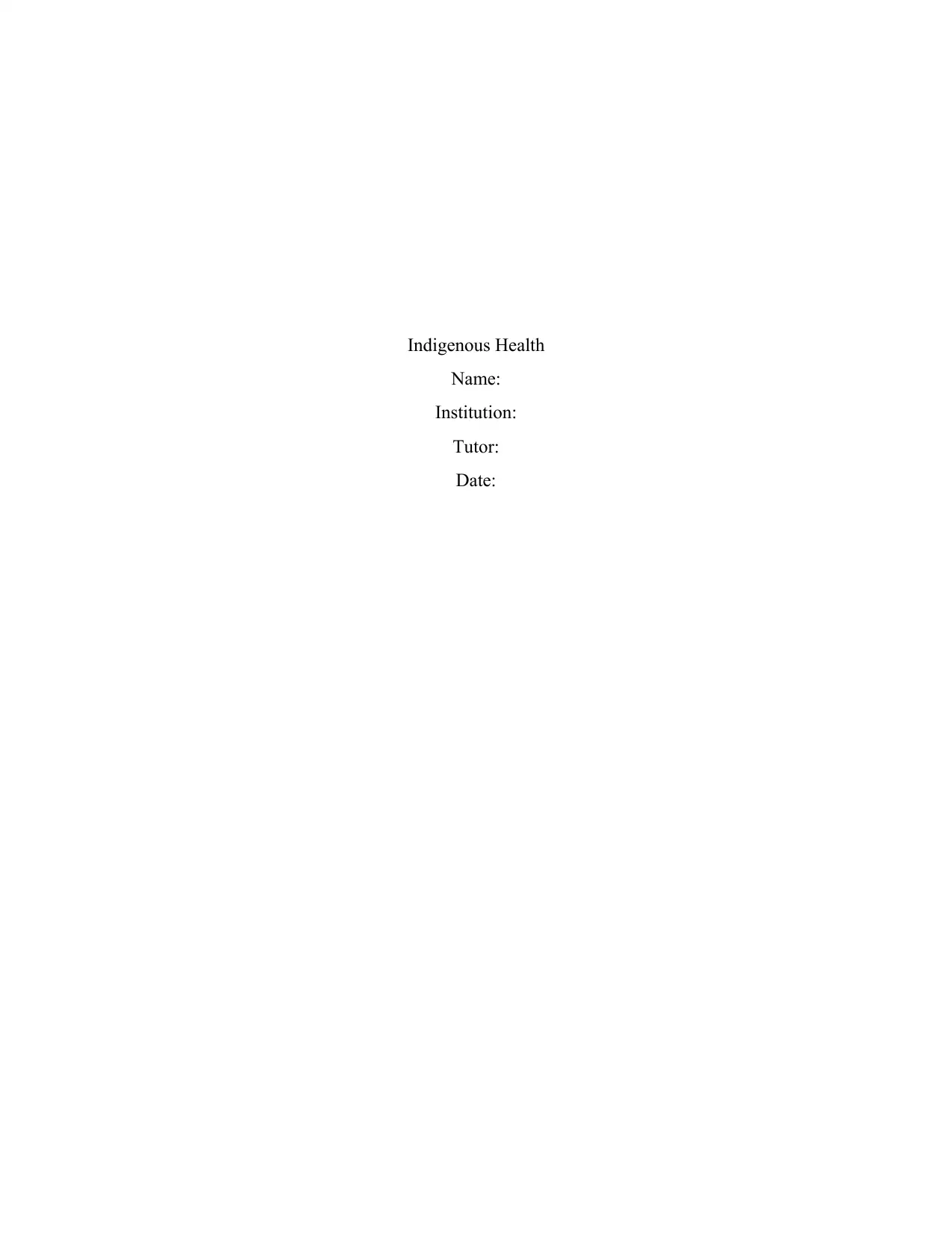
Indigenous Health
Name:
Institution:
Tutor:
Date:
Name:
Institution:
Tutor:
Date:
Secure Best Marks with AI Grader
Need help grading? Try our AI Grader for instant feedback on your assignments.
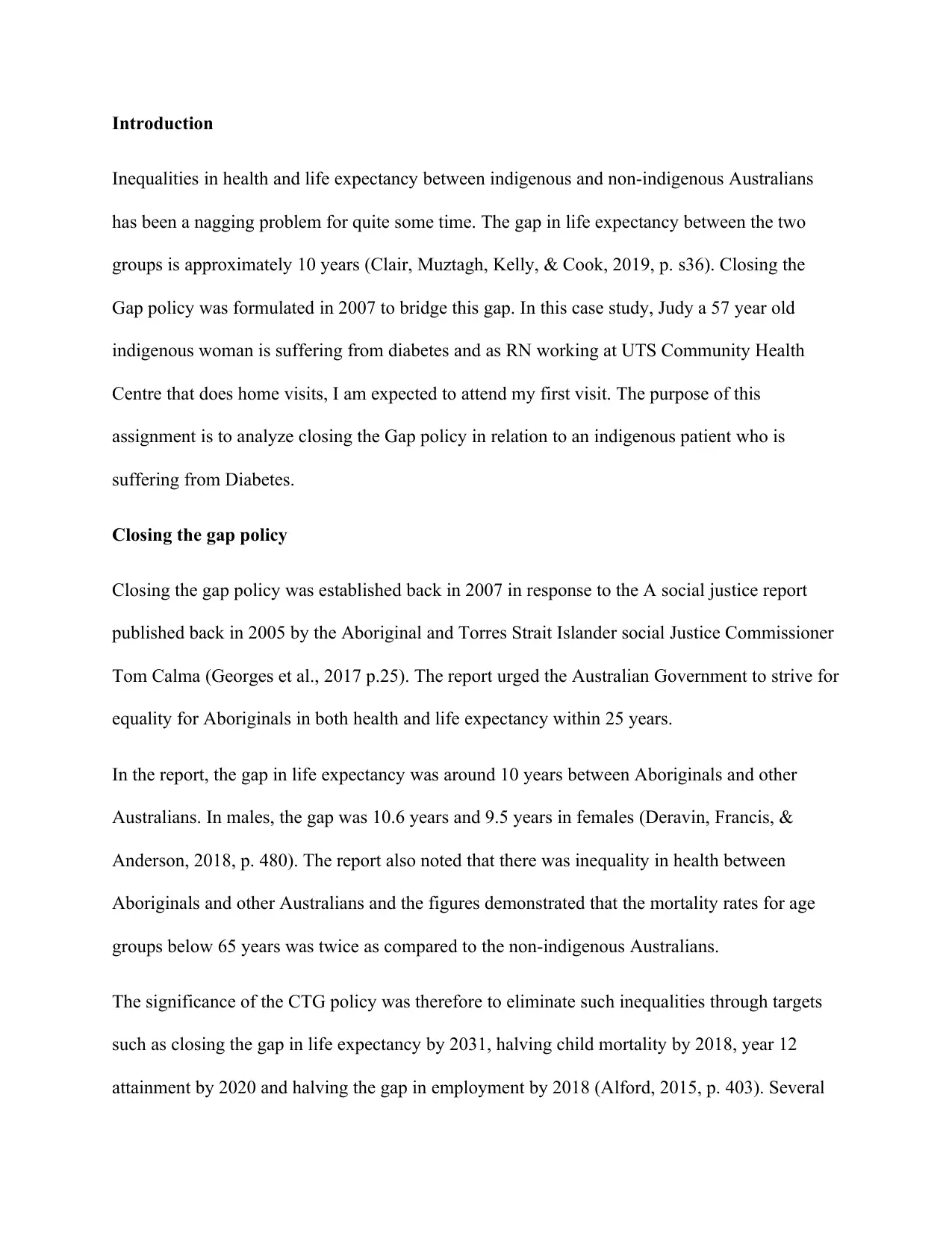
Introduction
Inequalities in health and life expectancy between indigenous and non-indigenous Australians
has been a nagging problem for quite some time. The gap in life expectancy between the two
groups is approximately 10 years (Clair, Muztagh, Kelly, & Cook, 2019, p. s36). Closing the
Gap policy was formulated in 2007 to bridge this gap. In this case study, Judy a 57 year old
indigenous woman is suffering from diabetes and as RN working at UTS Community Health
Centre that does home visits, I am expected to attend my first visit. The purpose of this
assignment is to analyze closing the Gap policy in relation to an indigenous patient who is
suffering from Diabetes.
Closing the gap policy
Closing the gap policy was established back in 2007 in response to the A social justice report
published back in 2005 by the Aboriginal and Torres Strait Islander social Justice Commissioner
Tom Calma (Georges et al., 2017 p.25). The report urged the Australian Government to strive for
equality for Aboriginals in both health and life expectancy within 25 years.
In the report, the gap in life expectancy was around 10 years between Aboriginals and other
Australians. In males, the gap was 10.6 years and 9.5 years in females (Deravin, Francis, &
Anderson, 2018, p. 480). The report also noted that there was inequality in health between
Aboriginals and other Australians and the figures demonstrated that the mortality rates for age
groups below 65 years was twice as compared to the non-indigenous Australians.
The significance of the CTG policy was therefore to eliminate such inequalities through targets
such as closing the gap in life expectancy by 2031, halving child mortality by 2018, year 12
attainment by 2020 and halving the gap in employment by 2018 (Alford, 2015, p. 403). Several
Inequalities in health and life expectancy between indigenous and non-indigenous Australians
has been a nagging problem for quite some time. The gap in life expectancy between the two
groups is approximately 10 years (Clair, Muztagh, Kelly, & Cook, 2019, p. s36). Closing the
Gap policy was formulated in 2007 to bridge this gap. In this case study, Judy a 57 year old
indigenous woman is suffering from diabetes and as RN working at UTS Community Health
Centre that does home visits, I am expected to attend my first visit. The purpose of this
assignment is to analyze closing the Gap policy in relation to an indigenous patient who is
suffering from Diabetes.
Closing the gap policy
Closing the gap policy was established back in 2007 in response to the A social justice report
published back in 2005 by the Aboriginal and Torres Strait Islander social Justice Commissioner
Tom Calma (Georges et al., 2017 p.25). The report urged the Australian Government to strive for
equality for Aboriginals in both health and life expectancy within 25 years.
In the report, the gap in life expectancy was around 10 years between Aboriginals and other
Australians. In males, the gap was 10.6 years and 9.5 years in females (Deravin, Francis, &
Anderson, 2018, p. 480). The report also noted that there was inequality in health between
Aboriginals and other Australians and the figures demonstrated that the mortality rates for age
groups below 65 years was twice as compared to the non-indigenous Australians.
The significance of the CTG policy was therefore to eliminate such inequalities through targets
such as closing the gap in life expectancy by 2031, halving child mortality by 2018, year 12
attainment by 2020 and halving the gap in employment by 2018 (Alford, 2015, p. 403). Several
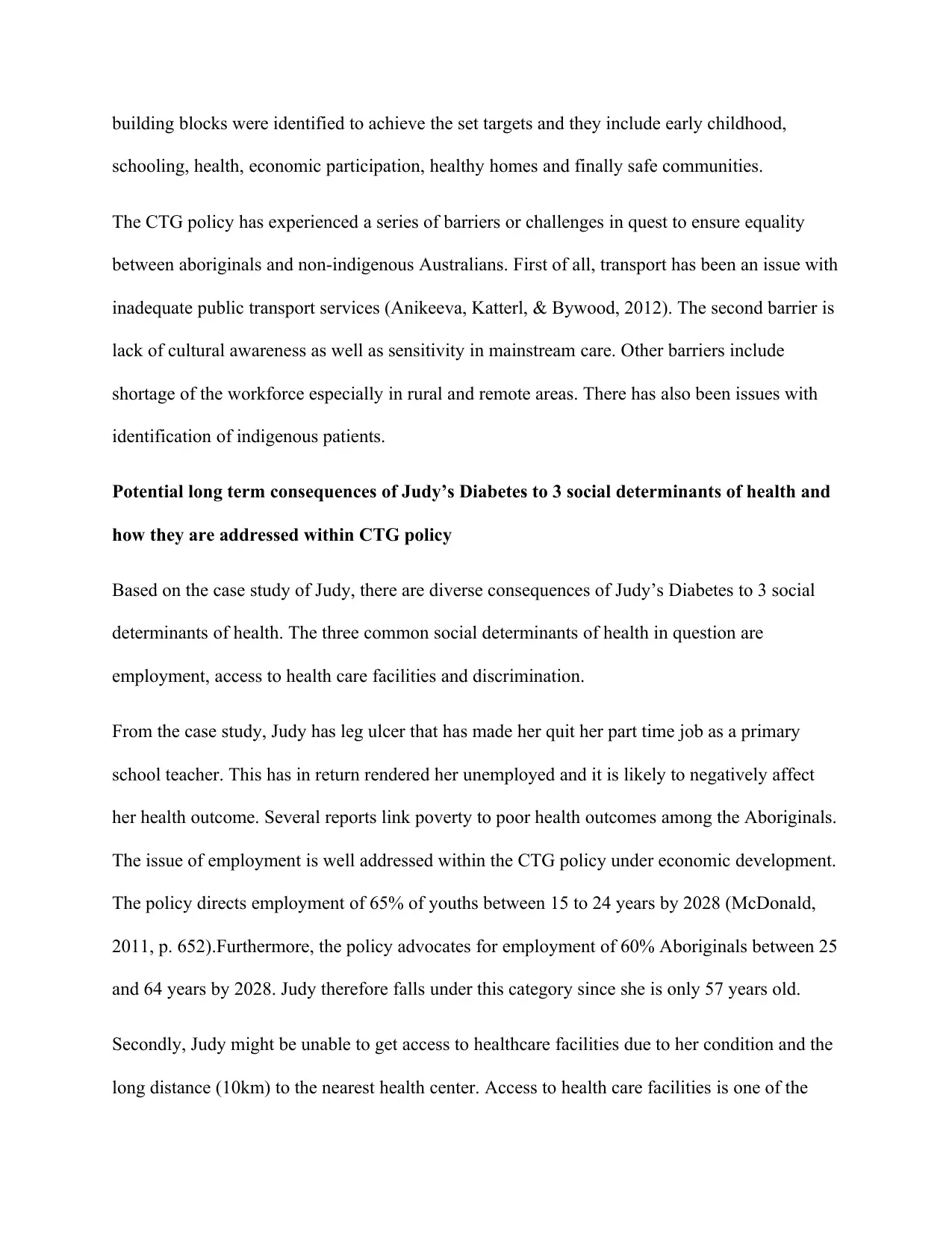
building blocks were identified to achieve the set targets and they include early childhood,
schooling, health, economic participation, healthy homes and finally safe communities.
The CTG policy has experienced a series of barriers or challenges in quest to ensure equality
between aboriginals and non-indigenous Australians. First of all, transport has been an issue with
inadequate public transport services (Anikeeva, Katterl, & Bywood, 2012). The second barrier is
lack of cultural awareness as well as sensitivity in mainstream care. Other barriers include
shortage of the workforce especially in rural and remote areas. There has also been issues with
identification of indigenous patients.
Potential long term consequences of Judy’s Diabetes to 3 social determinants of health and
how they are addressed within CTG policy
Based on the case study of Judy, there are diverse consequences of Judy’s Diabetes to 3 social
determinants of health. The three common social determinants of health in question are
employment, access to health care facilities and discrimination.
From the case study, Judy has leg ulcer that has made her quit her part time job as a primary
school teacher. This has in return rendered her unemployed and it is likely to negatively affect
her health outcome. Several reports link poverty to poor health outcomes among the Aboriginals.
The issue of employment is well addressed within the CTG policy under economic development.
The policy directs employment of 65% of youths between 15 to 24 years by 2028 (McDonald,
2011, p. 652).Furthermore, the policy advocates for employment of 60% Aboriginals between 25
and 64 years by 2028. Judy therefore falls under this category since she is only 57 years old.
Secondly, Judy might be unable to get access to healthcare facilities due to her condition and the
long distance (10km) to the nearest health center. Access to health care facilities is one of the
schooling, health, economic participation, healthy homes and finally safe communities.
The CTG policy has experienced a series of barriers or challenges in quest to ensure equality
between aboriginals and non-indigenous Australians. First of all, transport has been an issue with
inadequate public transport services (Anikeeva, Katterl, & Bywood, 2012). The second barrier is
lack of cultural awareness as well as sensitivity in mainstream care. Other barriers include
shortage of the workforce especially in rural and remote areas. There has also been issues with
identification of indigenous patients.
Potential long term consequences of Judy’s Diabetes to 3 social determinants of health and
how they are addressed within CTG policy
Based on the case study of Judy, there are diverse consequences of Judy’s Diabetes to 3 social
determinants of health. The three common social determinants of health in question are
employment, access to health care facilities and discrimination.
From the case study, Judy has leg ulcer that has made her quit her part time job as a primary
school teacher. This has in return rendered her unemployed and it is likely to negatively affect
her health outcome. Several reports link poverty to poor health outcomes among the Aboriginals.
The issue of employment is well addressed within the CTG policy under economic development.
The policy directs employment of 65% of youths between 15 to 24 years by 2028 (McDonald,
2011, p. 652).Furthermore, the policy advocates for employment of 60% Aboriginals between 25
and 64 years by 2028. Judy therefore falls under this category since she is only 57 years old.
Secondly, Judy might be unable to get access to healthcare facilities due to her condition and the
long distance (10km) to the nearest health center. Access to health care facilities is one of the
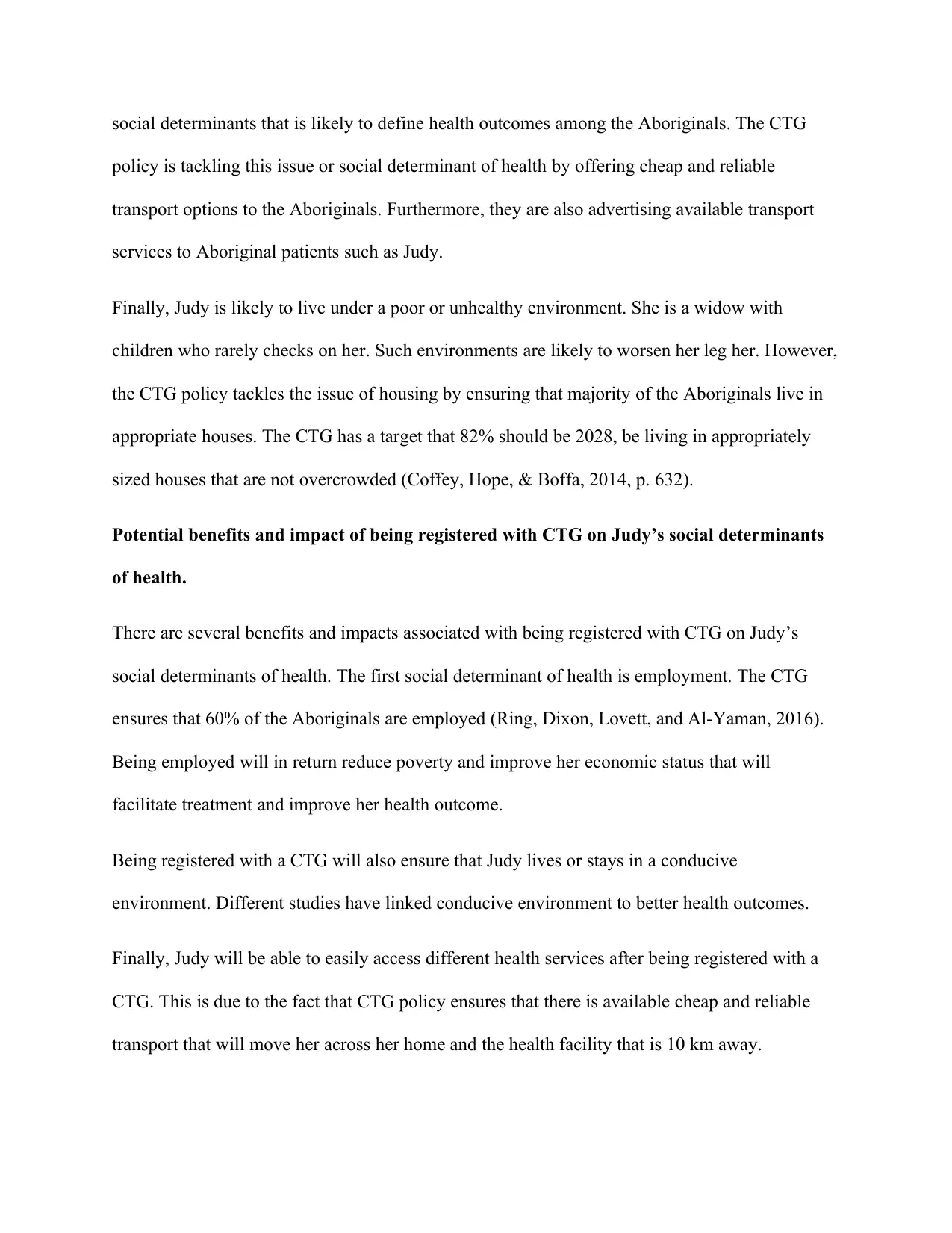
social determinants that is likely to define health outcomes among the Aboriginals. The CTG
policy is tackling this issue or social determinant of health by offering cheap and reliable
transport options to the Aboriginals. Furthermore, they are also advertising available transport
services to Aboriginal patients such as Judy.
Finally, Judy is likely to live under a poor or unhealthy environment. She is a widow with
children who rarely checks on her. Such environments are likely to worsen her leg her. However,
the CTG policy tackles the issue of housing by ensuring that majority of the Aboriginals live in
appropriate houses. The CTG has a target that 82% should be 2028, be living in appropriately
sized houses that are not overcrowded (Coffey, Hope, & Boffa, 2014, p. 632).
Potential benefits and impact of being registered with CTG on Judy’s social determinants
of health.
There are several benefits and impacts associated with being registered with CTG on Judy’s
social determinants of health. The first social determinant of health is employment. The CTG
ensures that 60% of the Aboriginals are employed (Ring, Dixon, Lovett, and Al-Yaman, 2016).
Being employed will in return reduce poverty and improve her economic status that will
facilitate treatment and improve her health outcome.
Being registered with a CTG will also ensure that Judy lives or stays in a conducive
environment. Different studies have linked conducive environment to better health outcomes.
Finally, Judy will be able to easily access different health services after being registered with a
CTG. This is due to the fact that CTG policy ensures that there is available cheap and reliable
transport that will move her across her home and the health facility that is 10 km away.
policy is tackling this issue or social determinant of health by offering cheap and reliable
transport options to the Aboriginals. Furthermore, they are also advertising available transport
services to Aboriginal patients such as Judy.
Finally, Judy is likely to live under a poor or unhealthy environment. She is a widow with
children who rarely checks on her. Such environments are likely to worsen her leg her. However,
the CTG policy tackles the issue of housing by ensuring that majority of the Aboriginals live in
appropriate houses. The CTG has a target that 82% should be 2028, be living in appropriately
sized houses that are not overcrowded (Coffey, Hope, & Boffa, 2014, p. 632).
Potential benefits and impact of being registered with CTG on Judy’s social determinants
of health.
There are several benefits and impacts associated with being registered with CTG on Judy’s
social determinants of health. The first social determinant of health is employment. The CTG
ensures that 60% of the Aboriginals are employed (Ring, Dixon, Lovett, and Al-Yaman, 2016).
Being employed will in return reduce poverty and improve her economic status that will
facilitate treatment and improve her health outcome.
Being registered with a CTG will also ensure that Judy lives or stays in a conducive
environment. Different studies have linked conducive environment to better health outcomes.
Finally, Judy will be able to easily access different health services after being registered with a
CTG. This is due to the fact that CTG policy ensures that there is available cheap and reliable
transport that will move her across her home and the health facility that is 10 km away.
Secure Best Marks with AI Grader
Need help grading? Try our AI Grader for instant feedback on your assignments.
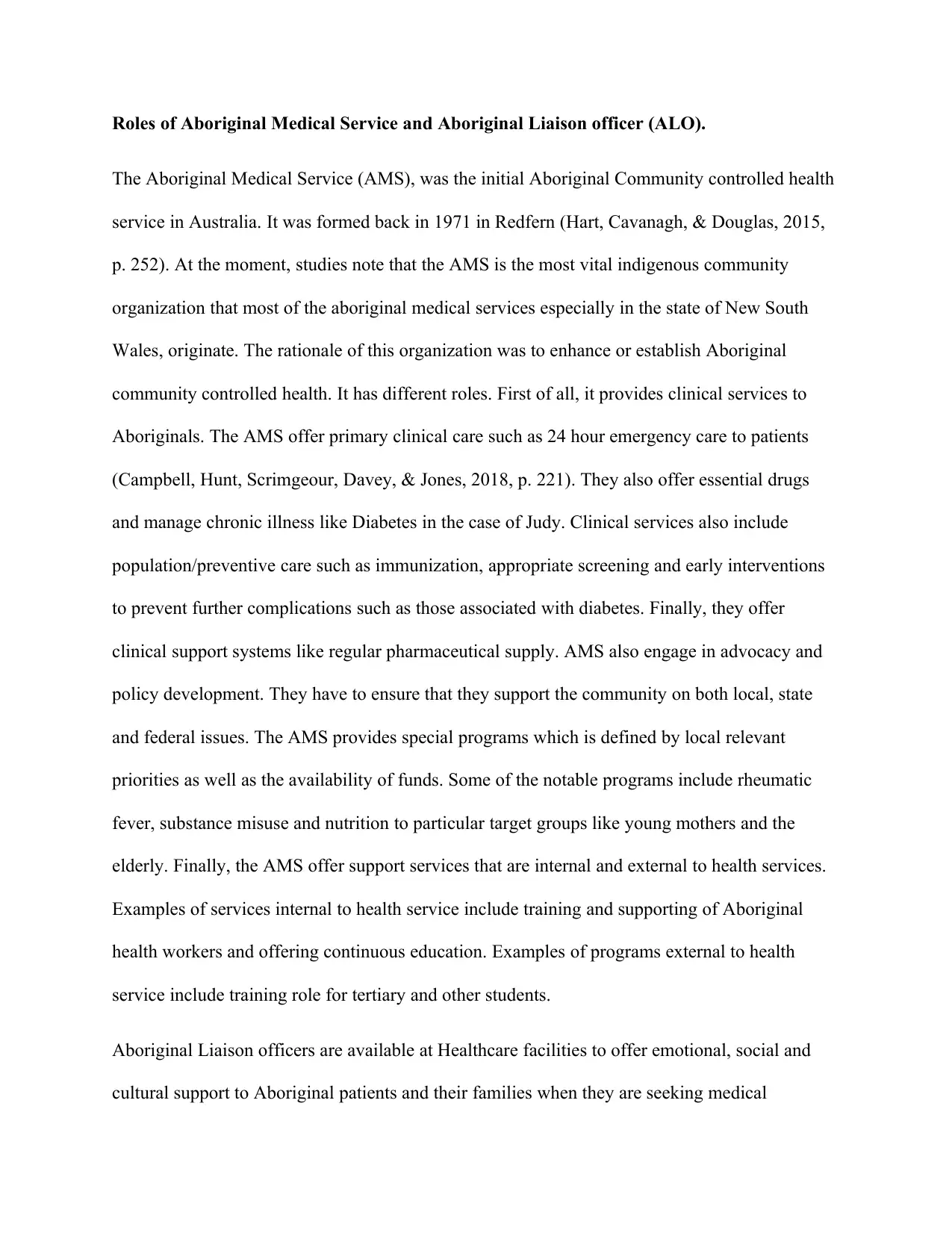
Roles of Aboriginal Medical Service and Aboriginal Liaison officer (ALO).
The Aboriginal Medical Service (AMS), was the initial Aboriginal Community controlled health
service in Australia. It was formed back in 1971 in Redfern (Hart, Cavanagh, & Douglas, 2015,
p. 252). At the moment, studies note that the AMS is the most vital indigenous community
organization that most of the aboriginal medical services especially in the state of New South
Wales, originate. The rationale of this organization was to enhance or establish Aboriginal
community controlled health. It has different roles. First of all, it provides clinical services to
Aboriginals. The AMS offer primary clinical care such as 24 hour emergency care to patients
(Campbell, Hunt, Scrimgeour, Davey, & Jones, 2018, p. 221). They also offer essential drugs
and manage chronic illness like Diabetes in the case of Judy. Clinical services also include
population/preventive care such as immunization, appropriate screening and early interventions
to prevent further complications such as those associated with diabetes. Finally, they offer
clinical support systems like regular pharmaceutical supply. AMS also engage in advocacy and
policy development. They have to ensure that they support the community on both local, state
and federal issues. The AMS provides special programs which is defined by local relevant
priorities as well as the availability of funds. Some of the notable programs include rheumatic
fever, substance misuse and nutrition to particular target groups like young mothers and the
elderly. Finally, the AMS offer support services that are internal and external to health services.
Examples of services internal to health service include training and supporting of Aboriginal
health workers and offering continuous education. Examples of programs external to health
service include training role for tertiary and other students.
Aboriginal Liaison officers are available at Healthcare facilities to offer emotional, social and
cultural support to Aboriginal patients and their families when they are seeking medical
The Aboriginal Medical Service (AMS), was the initial Aboriginal Community controlled health
service in Australia. It was formed back in 1971 in Redfern (Hart, Cavanagh, & Douglas, 2015,
p. 252). At the moment, studies note that the AMS is the most vital indigenous community
organization that most of the aboriginal medical services especially in the state of New South
Wales, originate. The rationale of this organization was to enhance or establish Aboriginal
community controlled health. It has different roles. First of all, it provides clinical services to
Aboriginals. The AMS offer primary clinical care such as 24 hour emergency care to patients
(Campbell, Hunt, Scrimgeour, Davey, & Jones, 2018, p. 221). They also offer essential drugs
and manage chronic illness like Diabetes in the case of Judy. Clinical services also include
population/preventive care such as immunization, appropriate screening and early interventions
to prevent further complications such as those associated with diabetes. Finally, they offer
clinical support systems like regular pharmaceutical supply. AMS also engage in advocacy and
policy development. They have to ensure that they support the community on both local, state
and federal issues. The AMS provides special programs which is defined by local relevant
priorities as well as the availability of funds. Some of the notable programs include rheumatic
fever, substance misuse and nutrition to particular target groups like young mothers and the
elderly. Finally, the AMS offer support services that are internal and external to health services.
Examples of services internal to health service include training and supporting of Aboriginal
health workers and offering continuous education. Examples of programs external to health
service include training role for tertiary and other students.
Aboriginal Liaison officers are available at Healthcare facilities to offer emotional, social and
cultural support to Aboriginal patients and their families when they are seeking medical
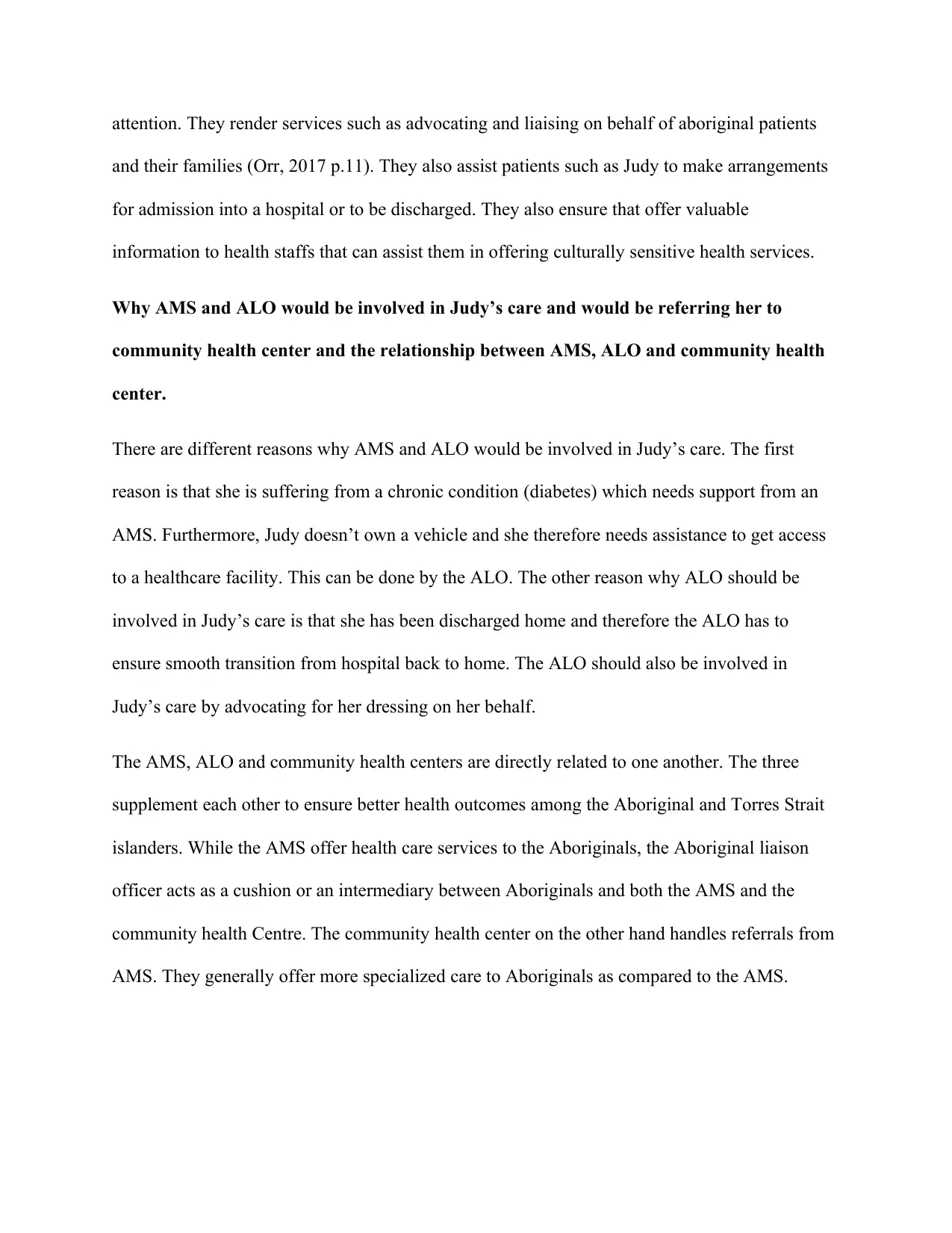
attention. They render services such as advocating and liaising on behalf of aboriginal patients
and their families (Orr, 2017 p.11). They also assist patients such as Judy to make arrangements
for admission into a hospital or to be discharged. They also ensure that offer valuable
information to health staffs that can assist them in offering culturally sensitive health services.
Why AMS and ALO would be involved in Judy’s care and would be referring her to
community health center and the relationship between AMS, ALO and community health
center.
There are different reasons why AMS and ALO would be involved in Judy’s care. The first
reason is that she is suffering from a chronic condition (diabetes) which needs support from an
AMS. Furthermore, Judy doesn’t own a vehicle and she therefore needs assistance to get access
to a healthcare facility. This can be done by the ALO. The other reason why ALO should be
involved in Judy’s care is that she has been discharged home and therefore the ALO has to
ensure smooth transition from hospital back to home. The ALO should also be involved in
Judy’s care by advocating for her dressing on her behalf.
The AMS, ALO and community health centers are directly related to one another. The three
supplement each other to ensure better health outcomes among the Aboriginal and Torres Strait
islanders. While the AMS offer health care services to the Aboriginals, the Aboriginal liaison
officer acts as a cushion or an intermediary between Aboriginals and both the AMS and the
community health Centre. The community health center on the other hand handles referrals from
AMS. They generally offer more specialized care to Aboriginals as compared to the AMS.
and their families (Orr, 2017 p.11). They also assist patients such as Judy to make arrangements
for admission into a hospital or to be discharged. They also ensure that offer valuable
information to health staffs that can assist them in offering culturally sensitive health services.
Why AMS and ALO would be involved in Judy’s care and would be referring her to
community health center and the relationship between AMS, ALO and community health
center.
There are different reasons why AMS and ALO would be involved in Judy’s care. The first
reason is that she is suffering from a chronic condition (diabetes) which needs support from an
AMS. Furthermore, Judy doesn’t own a vehicle and she therefore needs assistance to get access
to a healthcare facility. This can be done by the ALO. The other reason why ALO should be
involved in Judy’s care is that she has been discharged home and therefore the ALO has to
ensure smooth transition from hospital back to home. The ALO should also be involved in
Judy’s care by advocating for her dressing on her behalf.
The AMS, ALO and community health centers are directly related to one another. The three
supplement each other to ensure better health outcomes among the Aboriginal and Torres Strait
islanders. While the AMS offer health care services to the Aboriginals, the Aboriginal liaison
officer acts as a cushion or an intermediary between Aboriginals and both the AMS and the
community health Centre. The community health center on the other hand handles referrals from
AMS. They generally offer more specialized care to Aboriginals as compared to the AMS.
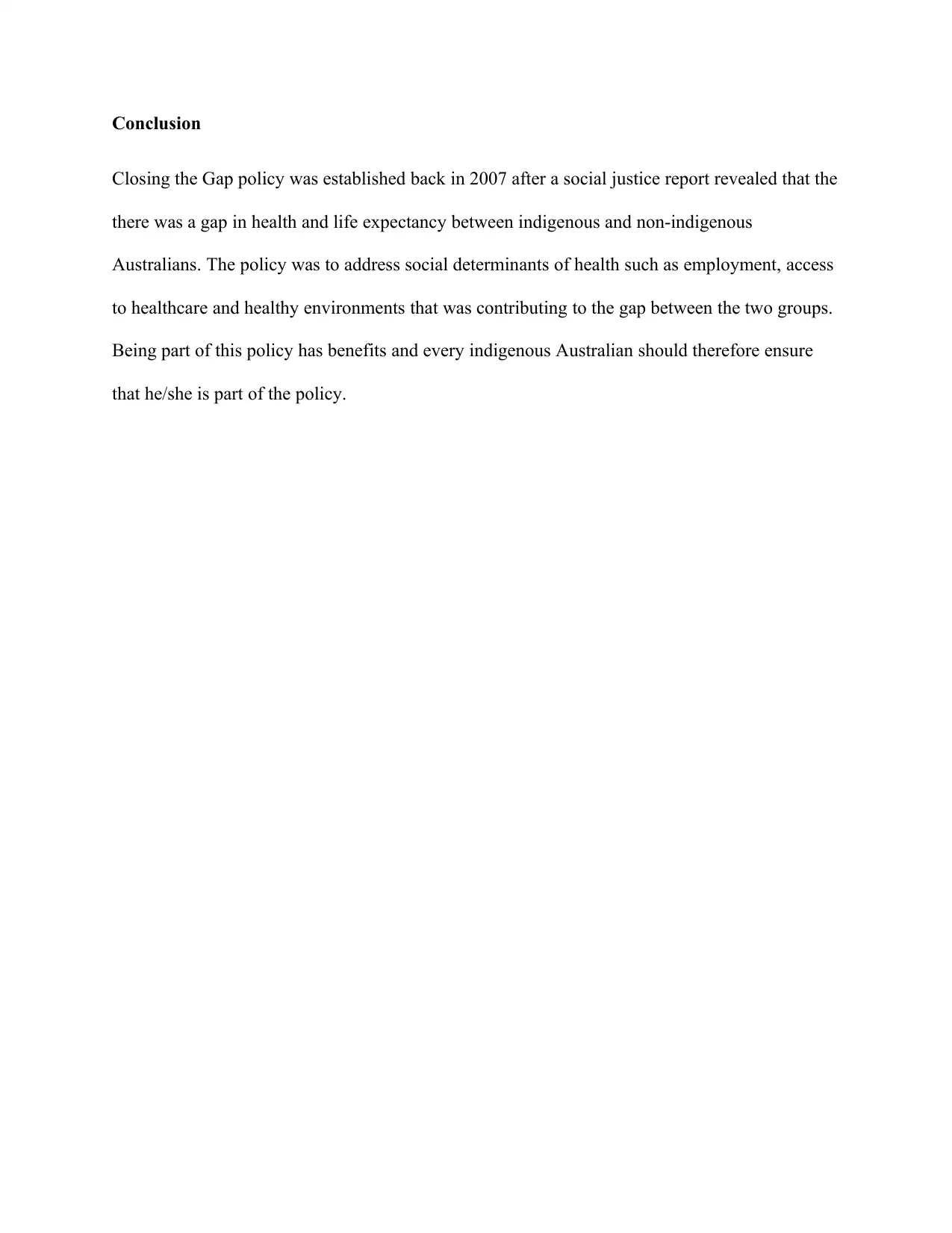
Conclusion
Closing the Gap policy was established back in 2007 after a social justice report revealed that the
there was a gap in health and life expectancy between indigenous and non-indigenous
Australians. The policy was to address social determinants of health such as employment, access
to healthcare and healthy environments that was contributing to the gap between the two groups.
Being part of this policy has benefits and every indigenous Australian should therefore ensure
that he/she is part of the policy.
Closing the Gap policy was established back in 2007 after a social justice report revealed that the
there was a gap in health and life expectancy between indigenous and non-indigenous
Australians. The policy was to address social determinants of health such as employment, access
to healthcare and healthy environments that was contributing to the gap between the two groups.
Being part of this policy has benefits and every indigenous Australian should therefore ensure
that he/she is part of the policy.
Paraphrase This Document
Need a fresh take? Get an instant paraphrase of this document with our AI Paraphraser
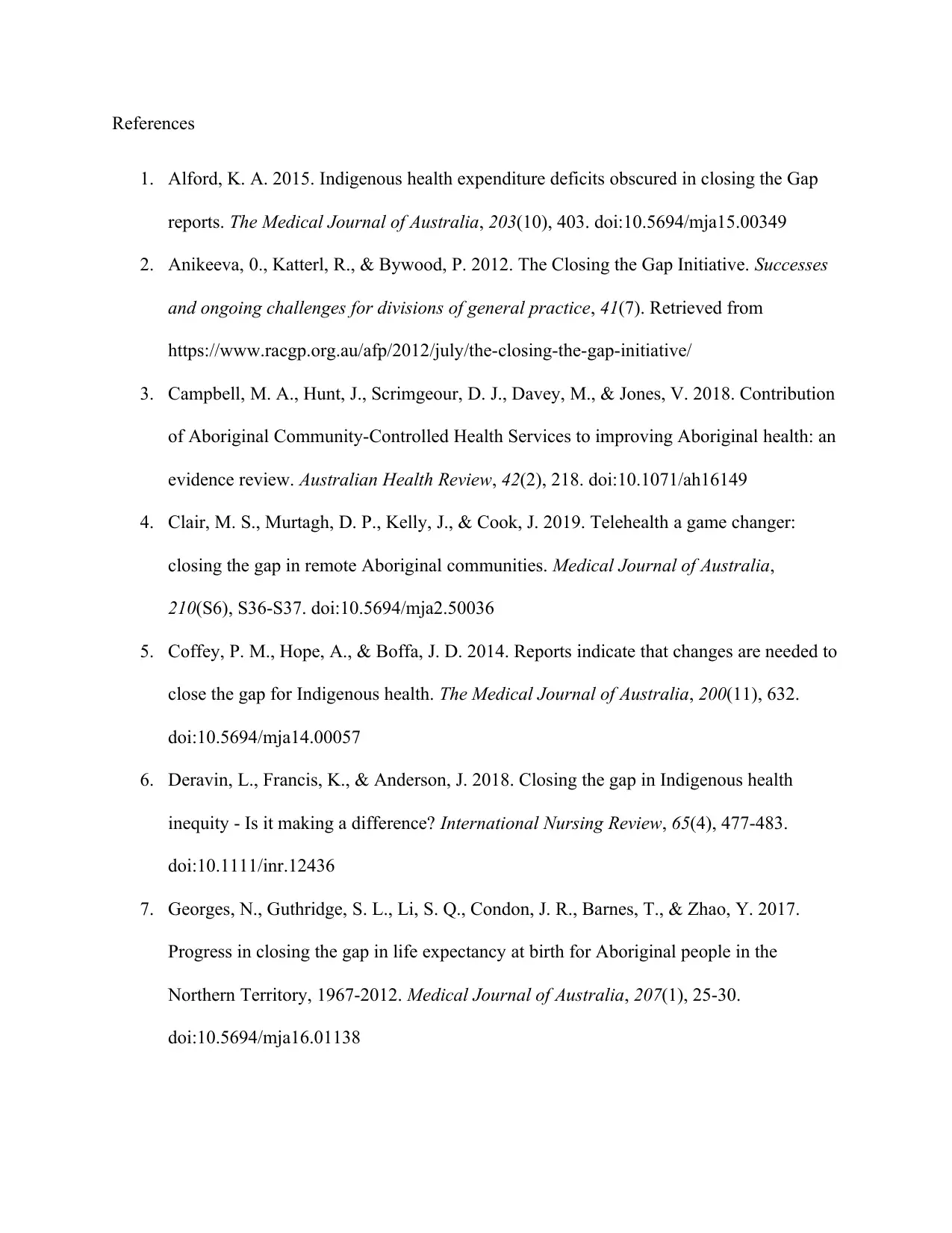
References
1. Alford, K. A. 2015. Indigenous health expenditure deficits obscured in closing the Gap
reports. The Medical Journal of Australia, 203(10), 403. doi:10.5694/mja15.00349
2. Anikeeva, 0., Katterl, R., & Bywood, P. 2012. The Closing the Gap Initiative. Successes
and ongoing challenges for divisions of general practice, 41(7). Retrieved from
https://www.racgp.org.au/afp/2012/july/the-closing-the-gap-initiative/
3. Campbell, M. A., Hunt, J., Scrimgeour, D. J., Davey, M., & Jones, V. 2018. Contribution
of Aboriginal Community-Controlled Health Services to improving Aboriginal health: an
evidence review. Australian Health Review, 42(2), 218. doi:10.1071/ah16149
4. Clair, M. S., Murtagh, D. P., Kelly, J., & Cook, J. 2019. Telehealth a game changer:
closing the gap in remote Aboriginal communities. Medical Journal of Australia,
210(S6), S36-S37. doi:10.5694/mja2.50036
5. Coffey, P. M., Hope, A., & Boffa, J. D. 2014. Reports indicate that changes are needed to
close the gap for Indigenous health. The Medical Journal of Australia, 200(11), 632.
doi:10.5694/mja14.00057
6. Deravin, L., Francis, K., & Anderson, J. 2018. Closing the gap in Indigenous health
inequity - Is it making a difference? International Nursing Review, 65(4), 477-483.
doi:10.1111/inr.12436
7. Georges, N., Guthridge, S. L., Li, S. Q., Condon, J. R., Barnes, T., & Zhao, Y. 2017.
Progress in closing the gap in life expectancy at birth for Aboriginal people in the
Northern Territory, 1967-2012. Medical Journal of Australia, 207(1), 25-30.
doi:10.5694/mja16.01138
1. Alford, K. A. 2015. Indigenous health expenditure deficits obscured in closing the Gap
reports. The Medical Journal of Australia, 203(10), 403. doi:10.5694/mja15.00349
2. Anikeeva, 0., Katterl, R., & Bywood, P. 2012. The Closing the Gap Initiative. Successes
and ongoing challenges for divisions of general practice, 41(7). Retrieved from
https://www.racgp.org.au/afp/2012/july/the-closing-the-gap-initiative/
3. Campbell, M. A., Hunt, J., Scrimgeour, D. J., Davey, M., & Jones, V. 2018. Contribution
of Aboriginal Community-Controlled Health Services to improving Aboriginal health: an
evidence review. Australian Health Review, 42(2), 218. doi:10.1071/ah16149
4. Clair, M. S., Murtagh, D. P., Kelly, J., & Cook, J. 2019. Telehealth a game changer:
closing the gap in remote Aboriginal communities. Medical Journal of Australia,
210(S6), S36-S37. doi:10.5694/mja2.50036
5. Coffey, P. M., Hope, A., & Boffa, J. D. 2014. Reports indicate that changes are needed to
close the gap for Indigenous health. The Medical Journal of Australia, 200(11), 632.
doi:10.5694/mja14.00057
6. Deravin, L., Francis, K., & Anderson, J. 2018. Closing the gap in Indigenous health
inequity - Is it making a difference? International Nursing Review, 65(4), 477-483.
doi:10.1111/inr.12436
7. Georges, N., Guthridge, S. L., Li, S. Q., Condon, J. R., Barnes, T., & Zhao, Y. 2017.
Progress in closing the gap in life expectancy at birth for Aboriginal people in the
Northern Territory, 1967-2012. Medical Journal of Australia, 207(1), 25-30.
doi:10.5694/mja16.01138
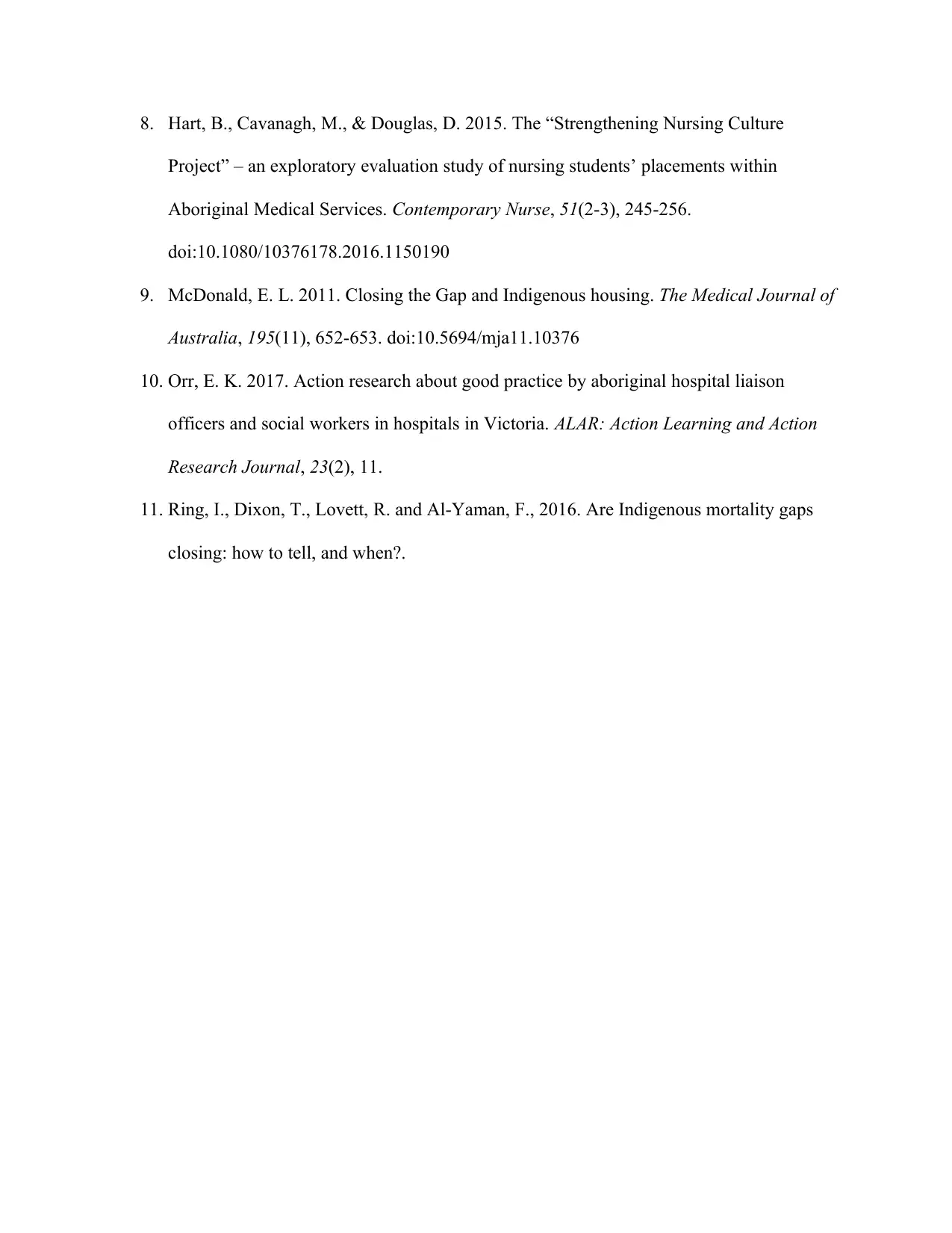
8. Hart, B., Cavanagh, M., & Douglas, D. 2015. The “Strengthening Nursing Culture
Project” – an exploratory evaluation study of nursing students’ placements within
Aboriginal Medical Services. Contemporary Nurse, 51(2-3), 245-256.
doi:10.1080/10376178.2016.1150190
9. McDonald, E. L. 2011. Closing the Gap and Indigenous housing. The Medical Journal of
Australia, 195(11), 652-653. doi:10.5694/mja11.10376
10. Orr, E. K. 2017. Action research about good practice by aboriginal hospital liaison
officers and social workers in hospitals in Victoria. ALAR: Action Learning and Action
Research Journal, 23(2), 11.
11. Ring, I., Dixon, T., Lovett, R. and Al-Yaman, F., 2016. Are Indigenous mortality gaps
closing: how to tell, and when?.
Project” – an exploratory evaluation study of nursing students’ placements within
Aboriginal Medical Services. Contemporary Nurse, 51(2-3), 245-256.
doi:10.1080/10376178.2016.1150190
9. McDonald, E. L. 2011. Closing the Gap and Indigenous housing. The Medical Journal of
Australia, 195(11), 652-653. doi:10.5694/mja11.10376
10. Orr, E. K. 2017. Action research about good practice by aboriginal hospital liaison
officers and social workers in hospitals in Victoria. ALAR: Action Learning and Action
Research Journal, 23(2), 11.
11. Ring, I., Dixon, T., Lovett, R. and Al-Yaman, F., 2016. Are Indigenous mortality gaps
closing: how to tell, and when?.
1 out of 9
Related Documents
Your All-in-One AI-Powered Toolkit for Academic Success.
+13062052269
info@desklib.com
Available 24*7 on WhatsApp / Email
![[object Object]](/_next/static/media/star-bottom.7253800d.svg)
Unlock your academic potential
© 2024 | Zucol Services PVT LTD | All rights reserved.





